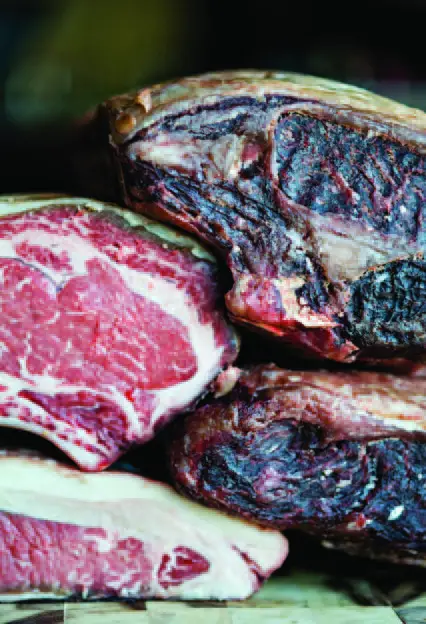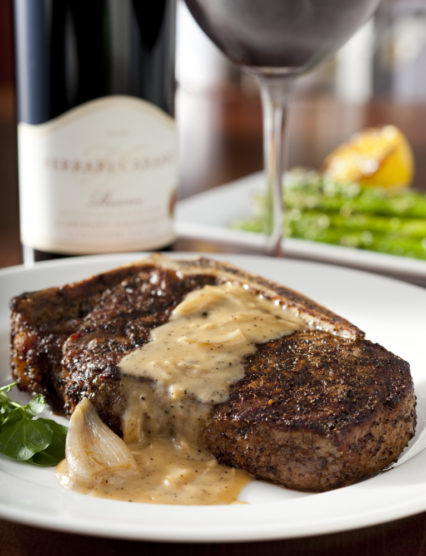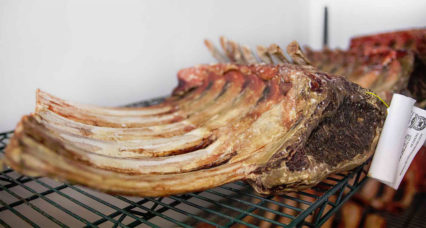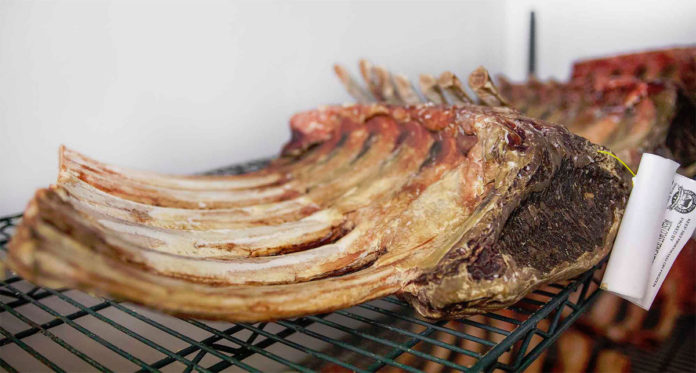By Taryn Sauer
DRY-AGED BEEF IS SAID TO BE ONE OF THE MOST LUSCIOUS STEAKS, enhancing hidden flavors in the meat, such as its nutty and earthy aromas—some have even been reported to produce hints of strawberries and so tender, it hardly needs a knife. As opposed to what most consumers have come to know as wet-aged beef, dry-aged beef remains, in some way, superior in quality and taste—but all of that depends on who’s doing the chewing.
As West Coast Prime Meats’ Business Development Specialist, John Reese puts it:
“[The taste] is all subject to different points of views and palates of the end user.”
Wet-aged beef is either typically vacuum sealed for a four-day transit to the local grocer, or
refrigerated for a minimum of three weeks, able to soak in its own juices, producing a metallic-like flavor normally associated with most restaurant goers’ dining experience.
Dry-aging meats is rich in tradition—a process associated with the timelessness of “old world”
cooking. And contrary to wet-aged beef, it holds the potential to be even more moist due to its higher fat-to-meat ratio. And because of its deep flavor profile, it beckons more salivation.
This delicacy is achieved through a highly sensitive aging process that has nothing to do
with chance and everything to do with control.
Meats are aged a minimum of 18 days in a locker set to below 40 degrees Fahrenheit, on
average. UV lights keep the bad bacteria at bay. Enzymes in the meat break down proteins into amino acids, carbohydrates into sugars and dwindle away at connective tissues around protein strands, thus tenderizing the meat. Through this temperature and moisture-

controlled process, the meat can lose up to 50 percent of its weight. What’s left is a marbled steak with superior umami. The longer it ages, the richer the flavor. But one wrong
step, and the beef can be rendered almost inedible, tasting like the dirt underneath cows’ hooves. With such a sensitive process, it’s no wonder why purveyors advise against dry-aging in-house. “To dry-age correctly, you really need to do your homework,” Jim Asher of Sterling Meat says. The amount of care required to produce even one quality, dry-aged rack of beef is why most restaurants source their dry-aged steaks from trusted purveyors.
But that doesn’t keep everyone from trying their hand at the rigorous process. The Catch entrusts this specialty to Chef Cory Rapp, who uses his past experience with in-house dry-aging. “I [am] able to expand on that knowledge and train our team on the correct cooking techniques and procedures to ensure every dry-aged steak is seasoned and cooked in a way that it highlights the natural flavors of the dry-aging process,” Rapp says.
And not all purveyors are weary on the idea of in-house dry-aging. “I think it’s great that more restaurants are dry-aging in-house,” says Jim Cascone of Huntington Meats. “As long as these chefs are using cases that ensure the proper temperature and air flow, the result should be a superior quality steak for their guests to enjoy. The key effect of dry-aging is the
concentration and saturation of the natural flavor, as well as the tenderization of the meat texture.”
“There is simply nothing like it,” he said. “Dry-aging adds unmatched flavor and tenderness that marinating just can’t touch.”
FLEMINGS’ ribeye is dry-aged in 13 different locations across the country
to the exact specification of 21 to 28 days.
LACAVE gets their 20+ day, dry-aged steaks from their suppliers.
ENOSTEAK’S ribeye is dry-aged for 28 days. Occasionally, they run a
special of 40-day dry-aged American Wagyu, and often they present dry-aged
meats as the butcher’s cut-of-the-day.
CHIANINA dry-ages their beef for 30 days through a purveyor, but are
currently conducting small experiments in-house.
The Restaurants’ Take
CAPITAL GRILLE, CHEF CHRIS HUTTEN
What do you see as the added benefits of dry-aged meat? Through dry-aging, we are able to intensify flavor and maximize the tenderness of our meat. Via controlled humidity and air flow, we remove moisture from the beef which provides our meat with flavor and tenderness that, we believe, is unparalleled. As you may know, purveyors generally advise against you dry-aging your goods in-house.
Why do you want to dry-age your own? When properly managed in a controlled environment, dry-aging yields excellent results. The process is managed under the watchful eyes of our in-house butcher and Executive Chef. We believe dry-aging in-house allows us to offer the most tender and flavorful cuts to our guests.

Where do you source your meat? Do they provide dry-aged product? Our Executive Chef has
impeccably high standards regarding the ingredients that are used in our restaurants. As such, our beef comes from the top ranchers in the United States.
How many days do you age in-house? It’s a process that takes 18 to 24 days under the careful supervision of our in-house butcher and Executive Chef.
Does the price that you charge depend on how long the cut has been aged? No.
What does your locker look like? Now, that’s a very well-kept secret.
Are all your cuts dry-aged? If not, which are? For our Bone-In Ribeye we use prime meat as this cut features a high amount of marbling and is especially flavorful when used with prime. Prime beef is graded based on the amount of marbling and tenderness. We use dry-aging for our other cuts of beef as we are able to truly intensify the flavor and tenderness through the dry-aging process.
What is your favorite cut? Hands down: the Porter House. It’s beautifully dry-aged and has the best of both worlds. With our Porter House, you get our NY Strip and Filet, separated by a flavor enhancing “T” shape bone.
THE CATCH, CHEF CORY RAPP
Why did you decide to add meats dry-aged in-house to your menu?
We want to enhance the overall guest experience. There are not many restaurants in Southern California that are dry-aging their own meats in-house which sets us apart.
What do you see as the added benefits of dry-aged meat? In my opinion, dry-aged meat provides the most well-rounded intense flavor of steak that you cannot get anywhere. When eating one of our dry-aged steaks, though not as juicy as your traditional wet aged steak, you can taste the minerality of the soil where the cow lived and the grass or grain that the animal fed on- it is just like the terroir from drinking a fine wine. A discerning palate can
pick up on the depth and unique characteristics from that steak. As you may know, purveyors generally advise against you dry-aging your goods in-house. Why do you want to dry-age your own? We really enjoy dry-aging our own meat here because we are in control of the entire process from start to finish. Wherever you dry-age meat, it is going to taste slightly
different, the humidity and temperature are a very big deal in creating an exceptional dry-aged steak and we like to be in control of that.
Where do you source your meat? Do they provide dry-aged product? We source our meat from the Mid-West, it is grain fed and always USDA Prime.
Yes, our purveyors do provide dry-aged products but we feel our flavor and process is superior.
How many days do you age in-house? The least amount of days we dry-age our steaks is 32, we have gone up to 75… so far.
Does the price that you charge depend on how long the cut has been aged?
Absolutely, the price has to go up the longer you dry-age the steak. The price goes up due to the high weight loss of the product, in some cases we have up to a 35 percent weight loss during the drying and trimming stage.
What does your locker look like? Our meat locker is on display in the front of the restaurant. We have an open kitchen and right underneath the pass is our humidity and temperature controlled meat locker. Having the locker in the front of the restaurant definitely draws attention from everyone who walks by and it gets them excited for what is to come.
Are all your cuts dry-aged? If not, which are? Not all of our meat is dry-aged due to some people not having an acquired taste for the product. On our menu we serve dry-aged 16oz Ribeye, 16oz New York, 2 lb Bone-in Ribeye and a 2.5 lb+ Ribeye.
Did you have to purchase special equipment? No, all of the equipment that we have is meant for dry-aging excellent cuts of beef. We use an Omni Temp Refrigerator.
Can the bone marrow of a dry-aged meat be used? If so, what can it be used for/how is it different? We do not offer any cuts that would have a large enough piece of bone to gather the marrow from it.
How many pounds per week do you serve? During a busy week we could serve up to 400 pounds of dry-aged meat, which is not including our wet aged steaks.
What is your favorite cut? My favorite cut is the bone-in Ribeye, I enjoy this cut due to the richness of the steak and the meat to fat ratio… any cut of meat with a bone always tastes better and has more flavor.
Enhancements on the menu? We offer many great enhancements to our steaks like bone marrow butter, seared foie gras, bacon-maytag butter, au poivre style and many more.
IL BARONE RISTORANTE, CHEF FRANCO BARONE
What do you see as the added benefits of dry-aged meat? Dry-aged beef develops a much more intense and richer flavor than beef that has not been dry-aged. As you may know, purveyors generally advise against you dry-aging your goods in-house.
Why do you want to dry-age your own? I like having complete control over the product I give my guests in the restaurant. By dry-aging my own beef I can determine how particular cuts are developing and know when the best time to present them to my guests.
Where do you source your meat? Do they provide dry-aged product? I have a couple of Purveyors who I’ve worked with for many years. They do provide dry-aging, but also understand and respect that I want to be able to control the aging of the steaks I offer in the restaurant.
How many days do you age in-house? Anywhere from 30 to 55 days. I like
to see how the flavors in the meat develop. After 50 days of dry-aging the beef really
develops a number of secondary and tertiary flavors that weren’t there before. I
really enjoy the intensity of the flavor and I think many of my guests do as well.
Does the price that you charge depend on how long the cut has been aged? Somewhat but really I want to make sure my guests get a great steak. I love hearing from guests that the steaks I present are equal to or better than premier steak houses.
What temperature? I keep temperature below 40 degrees.
Do you control the humidity? How does that work? The humidity is important and it must be
between 80 percent and 85 percent. At high levels of humidity mold growth is an issue. If the humidity is too low the beef will dry out too quickly and therefore cause the steak to have less juiciness than is needed.
Are all your cuts dry-aged? If not, which are? Not all. I like to age Ribeye’s, Porterhouse and New York.
What is your favorite cut? Ribeye.













